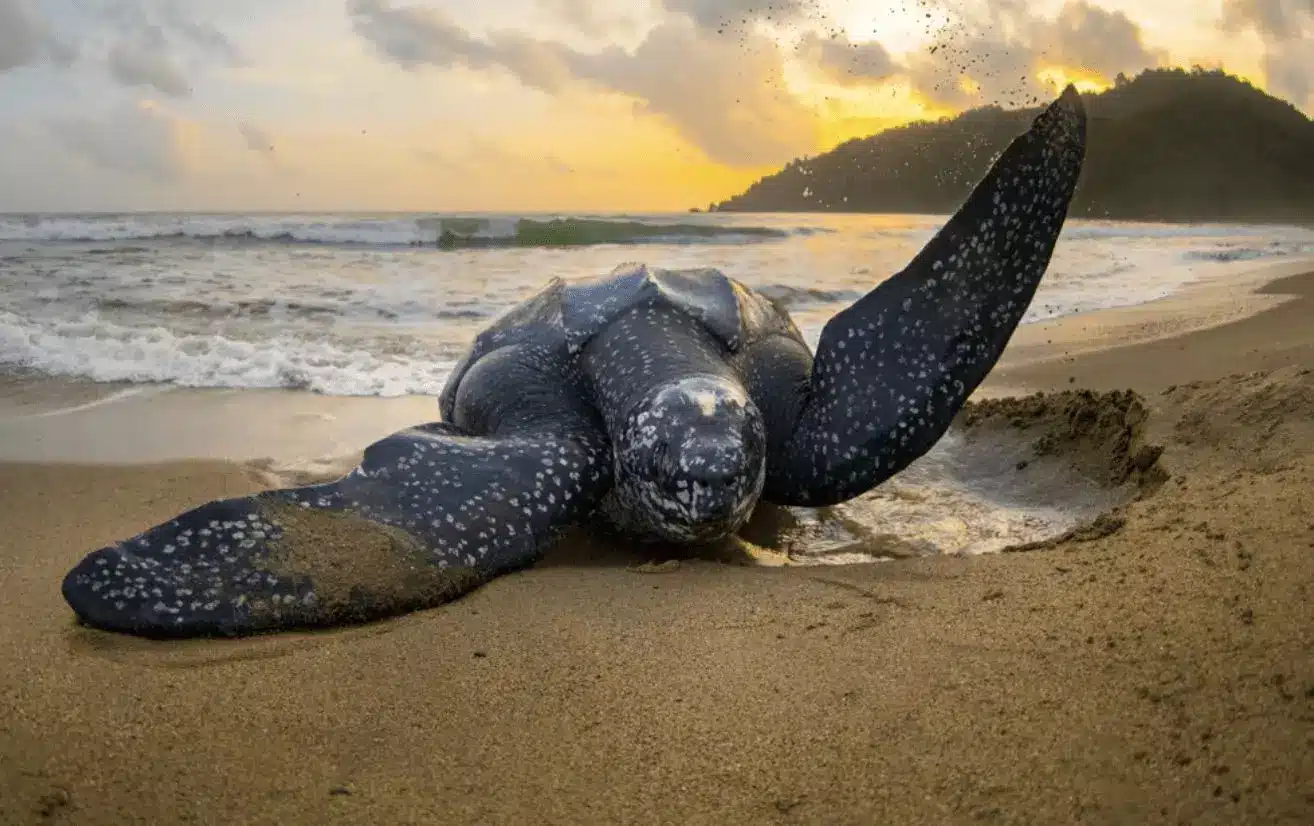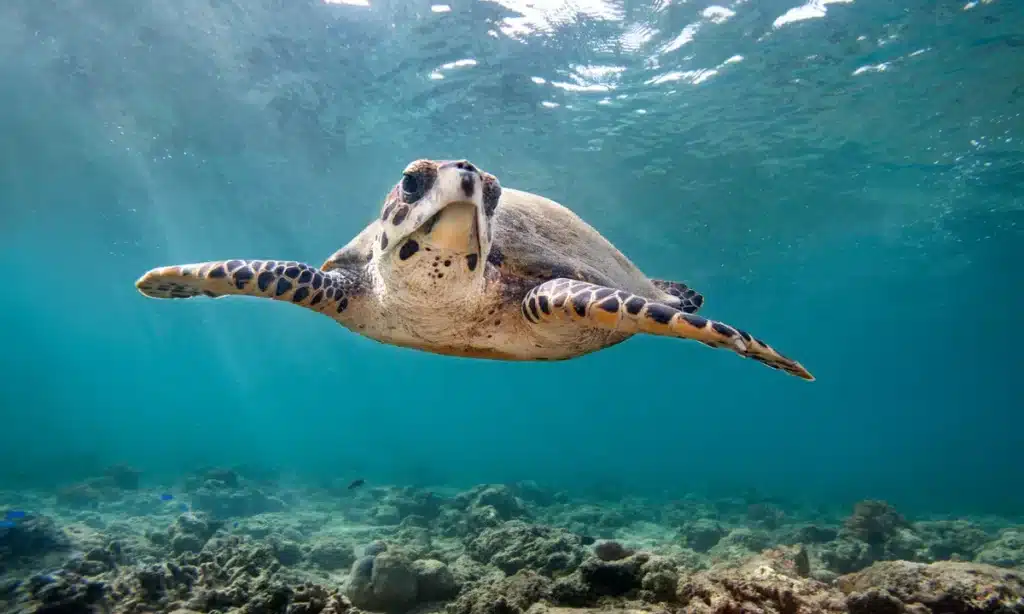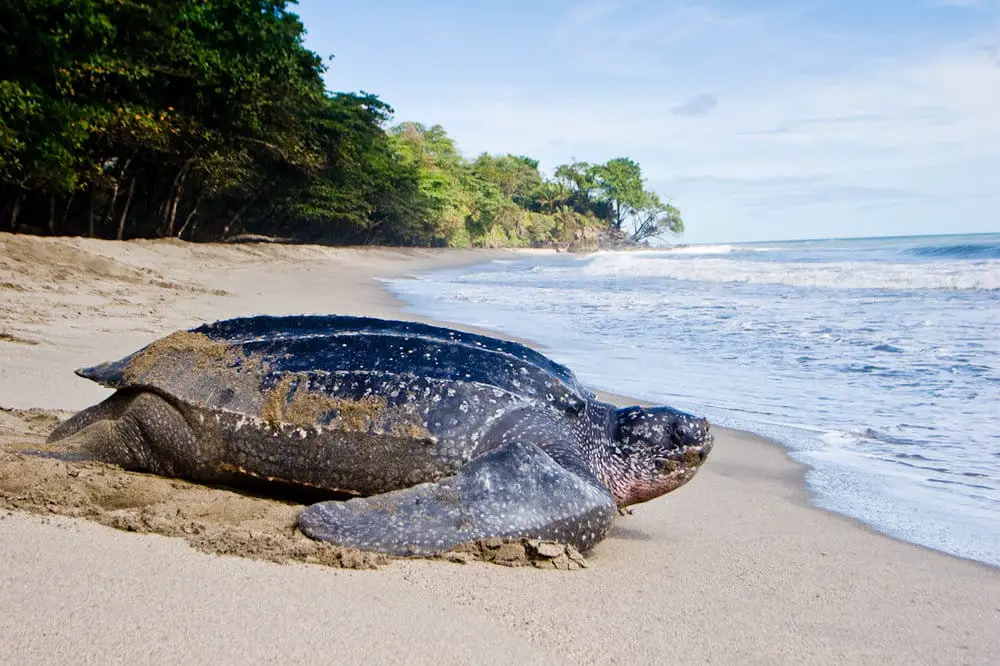Why Do Sea Turtles Migrate

Introduction
Why Do Sea Turtles Migrate: Sea turtles, the gentle giants of the ocean, embark on extraordinary journeys across the vast seas, captivating the imagination of scientists and nature enthusiasts alike. Their migration patterns have puzzled researchers for centuries, leading to a deeper exploration of why sea turtles migrate and how they navigate the oceans with remarkable precision.
The phenomenon of sea turtle migration is a captivating tale of survival, instinct, and adaptation. These ancient reptiles, which have existed for over 100 million years, undertake these journeys for several crucial reasons. One primary motivation is breeding. Female sea turtles return to the very beaches where they hatched, a remarkable feat of navigation known as natal homing, to lay their eggs.
Another critical aspect of sea turtle migration is feeding. As these reptiles are primarily herbivores or carnivores, they travel great distances to find their preferred food sources. The lush seagrass beds and coral reefs found in specific regions become feeding grounds for various sea turtle species. These migrations are essential for maintaining the delicate balance of marine ecosystems.
The answer lies in their remarkable ability to sense Earth’s magnetic fields, the stars, and even the temperature of the water. Understanding these navigation mechanisms is essential not only for unraveling the mysteries of sea turtle migration but also for conservation efforts aimed at protecting these endangered creatures.
We will delve deeper into the fascinating world of sea turtle migration, shedding light on the reasons behind incredible turtle journeys and the challenges they face in an ever-changing environment.

Do sea turtles migrate?
Sea turtles migrate thousands of miles in their lifetime through ocean basins and high seas. One female leatherback traveled more than 12,000 miles round-trip across the Pacific Ocean, from Papua in Indonesia to the northwest coast of the United States.
Sea turtles are renowned for their incredible migrations. They embark on long journeys across the world’s oceans, traveling thousands of miles throughout their lives. These migrations serve various crucial purposes in the sea turtle’s life cycle.
One of the most well-known reasons is reproduction. Female sea turtles return to the beaches where they were born, a phenomenon called natal homing, to lay their eggs. This ensures the survival of their species, as the hatchlings, once they emerge from their nests, begin their own adventurous oceanic voyages.
Aside from breeding, sea turtles migrate in search of food. Different species have distinct preferences, ranging from seagrass beds to coral reefs and jellyfish-rich waters. They follow their instincts and the changing seasons to locate these essential food sources, traveling across vast ocean expanses to sustain themselves.
These migrations are awe-inspiring feats, considering that sea turtles navigate the open seas without the aid of GPS or maps. Instead, they rely on a combination of their innate biological compass, celestial cues like the position of the stars, and sensory perceptions to chart their course.
What causes turtles to migrate?
Species often migrate in search of more favorable environmental conditions. Those favorable environmental conditions can include finding habitats with more food, along with increased breeding and/or nesting opportunities.
Turtles embark on migratory journeys driven by a combination of biological imperatives and environmental cues. One of the primary drivers is reproduction. Female turtles, with astonishing precision, return to their natal beaches to lay their eggs. This instinctual pilgrimage ensures the survival of their species and highlights the incredible navigational abilities these creatures possess. It’s a remarkable feat considering the vastness of the oceans and the accuracy with which they locate specific nesting sites.
Feeding is another pivotal factor in turtle migrations. Different species have varied dietary preferences, from herbivorous grazing on seagrasses to carnivorous diets that include jellyfish and crustaceans. They migrate to areas where their preferred food sources are abundant, often guided by oceanic currents and seasonal variations in prey availability.
Additionally, environmental factors play a significant role. Sea turtles are highly attuned to changes in temperature, water conditions, and the Earth’s magnetic field. These cues help them navigate across great distances, ensuring they reach their destination for nesting or feeding.
However, it’s crucial to acknowledge that human-induced factors such as climate change, habitat degradation, and pollution are now impacting these natural migratory patterns. Understanding the intricate web of factors that drive turtle migrations is essential for their conservation and the preservation of the delicate ecosystems they inhabit.
What are some interesting facts about sea turtles?
Sea turtles don’t retract into their shells.
Unlike other turtles, sea turtles cannot retract their flippers and head into their shells. Their streamlined shells and large paddle-shaped flippers make them very agile and graceful swimmers. In the water, their rear flippers are used as rudders, for steering.
Sea turtles, captivating denizens of the world’s oceans, harbor a trove of intriguing facts. These ancient creatures have graced our planet for over 100 million years, surviving the dinosaurs’ extinction. Remarkably, they possess a magnetic sense, aiding them in navigating vast ocean expanses with astonishing precision.
A sea turtle’s shell, known as a carapace, is a fusion of bone and cartilage, providing both protection and buoyancy. Astonishingly, sea turtles exhibit an endearing fidelity to their birthplace, often returning to the exact beach where they were hatched to lay their own eggs, a phenomenon known as natal homing. Their dietary preferences are equally fascinating, with herbivorous green sea turtles maintaining a primarily plant-based diet, while loggerheads and leatherbacks are formidable predators, feasting on jellyfish and crustaceans.
These marine wanderers are known for their extensive migrations, sometimes spanning thousands of miles, driven by nesting and feeding requirements. Some species, like the leatherback, are capable of enduring extreme cold, allowing them to range across a wider expanse of ocean.
Additionally, sea turtles are unique among reptiles for their ability to regulate body temperature, exhibiting traits associated with warm-blooded creatures. These captivating creatures embody an enduring mystique, captivating the imagination of scientists and nature enthusiasts alike, while underscoring the vital importance of preserving their habitats for generations to come.
Why do green turtles migrate?
Epic migrations
As adults they migrate every few years to forage for food and to nest. Green turtle swimming over coral. The distances they travel vary widely between individuals, from less than 8 kilometres to more than 2000 kilometres. How they navigate across such distances has not yet been determined.
Green turtles undertake migratory journeys for both nesting and feeding purposes, driven by an intricate interplay of biological instincts and environmental cues. Nesting is a critical aspect of their migratory behavior. Female green turtles return to their natal beaches, sometimes after several years, to lay their eggs.
On the other hand, green turtles are herbivores, primarily grazing on seagrasses and algae. They migrate to coastal areas and coral reefs, where these food sources are abundant. The availability of nutritious seagrass beds in specific regions dictates their feeding grounds, guiding their migratory patterns.
Oceanic currents, water temperatures, and the seasonal abundance of seagrasses influence the timing and routes of their migrations. As these turtles are highly sensitive to changes in their environment, disruptions caused by climate change and habitat destruction are increasingly impacting their migratory behavior. Understanding and preserving the habitats crucial for both nesting and feeding is essential in safeguarding the future of these remarkable creatures.
How long do sea turtles move?
The leatherback turtle can travel 16,000 km (10,000 miles) or more each year, crossing the entire Pacific Ocean in search of jellyfish, while loggerheads have been tracked traveling from Japan to Baja, a distance of 13,000 km (8,000 miles).
The migratory journeys of sea turtles are awe-inspiring in their scope and endurance. These ancient travelers can embark on journeys that span thousands of miles, traversing entire ocean basins. The duration of their movements varies depending on the species and the purpose of their migration. For instance, loggerhead turtles may travel vast distances across the Atlantic, from their nesting sites in the Americas to foraging grounds in Europe and Africa.
Leatherback turtles, known for their remarkable adaptability to cold waters, have been documented traveling even greater distances, with some individuals covering over 10,000 miles in a single year. This extensive migration allows them to access a broader range of feeding grounds.
Green sea turtles tend to exhibit more localized movements, shuttling between nesting beaches and nearby foraging areas. Yet, even these seemingly shorter journeys can involve hundreds of miles.
The migratory prowess of sea turtles is a testament to their remarkable biological adaptations and navigational abilities. It also underscores the importance of preserving their habitats and addressing the challenges posed by human activities, which increasingly threaten these extraordinary journeys.
When do sea turtles migrate?
Sea turtles exhibit diverse migration patterns and timings, depending on their species, geographic location, and specific purposes for migration. Here’s a general overview of when sea turtles migrate:
- Breeding Season: For many sea turtle species, migration often aligns with the breeding season, which typically occurs during the warmer months of the year. Female turtles return to their natal beaches to lay eggs, often from late spring to early summer. For instance, loggerhead turtles in the Mediterranean region typically nest from May to August.
- Feeding Season: The timing of migrations for feeding varies among species and regions. Some sea turtles, like green turtles, may migrate to their preferred feeding grounds when the water temperature and conditions are favorable. This can occur year-round in tropical areas with abundant food sources.
- Seasonal Changes: Migration patterns can also be influenced by seasonal changes. In colder regions, sea turtles may migrate to warmer waters during the winter months to avoid hypothermia, while in tropical regions, they may move to cooler waters during the hot summer to avoid overheating.
- Life Stage: The timing of migration may differ based on the turtle’s life stage. Young turtles might undertake migrations at different times than adults as they explore different habitats or search for food in their early years.
It’s important to note that the timing of sea turtle migrations can be influenced by various environmental factors, including water temperature, ocean currents, and food availability. Each sea turtle species has its unique migration schedule, making their movements a complex and intriguing aspect of their biology and ecology. Understanding these migration patterns is crucial for conservation efforts and the protection of these remarkable marine creatures.
Do they migrate alone or in groups?
Sea turtles generally migrate individually, with each turtle following its own internal compass and cues from the environment. Their journeys are solitary endeavors, driven by specific biological imperatives such as nesting or feeding. For instance, a female sea turtle will undertake a solo migration to return to the beach of her birth for nesting. This ensures the continuation of her species, and the process is carried out independently.
However, there are instances where sea turtles may congregate in specific areas, particularly during feeding or mating seasons. For example, certain foraging grounds may attract multiple turtles due to an abundance of preferred food sources. Likewise, during breeding seasons, males and females may gather in specific areas, such as coastal shallows or near coral reefs, to engage in courtship and mating.
Despite these occasional gatherings, the actual migratory journeys themselves remain largely solitary affairs. Each turtle relies on its own instincts and environmental cues to navigate the vast expanses of the ocean, demonstrating the remarkable individuality and adaptability of these ancient creatures.
Do all sea turtles return to their nesting beaches to lay eggs?
Sea turtles exhibit remarkable nesting behavior, but not all of them return to their original nesting beaches to lay eggs. While many species of sea turtles do display a strong nesting site fidelity, there are exceptions. For example, loggerhead and leatherback sea turtles are known for their high nest site fidelity, often returning to the exact beach where they hatched. This behavior ensures that their offspring have a better chance of survival since they are familiar with the environment.
In contrast, some sea turtle species, such as the olive ridley, are less faithful to specific nesting sites. Olive ridleys, in particular, are known for their mass nesting events, or arribadas, where thousands of females come ashore simultaneously at various beaches. These turtles do not always return to the beach of their birth, and instead, they may nest at different locations within their range.
So, while many sea turtles do exhibit a strong attachment to their original nesting sites, it’s not a universal rule. The nesting behavior of sea turtles varies among species, with some showing more site fidelity than others, reflecting the diversity and complexity of these magnificent creatures’ life histories.

Conclusion
The migratory behavior of sea turtles is a marvel of nature driven by a complex interplay of biological, ecological, and environmental factors. These ancient creatures embark on incredible journeys, often spanning thousands of miles, for various crucial purposes. Firstly, nesting is a primary motivation, with female sea turtles returning to their natal beaches to turtles lay eggs, ensuring the survival of their species. The availability of suitable nesting sites and the assurance of their offspring’s safety profoundly influence their migration patterns.
Sea turtles migrate to exploit favorable feeding grounds, a behavior influenced by oceanic currents, water temperatures, and the distribution of prey species. This quest for optimal foraging areas is essential for their growth, reproduction, and overall population health. It’s a delicate balance that shapes their migratory routes and timing.
Global environmental changes, including climate shifts and habitat degradation, are posing unprecedented challenges to sea turtle migrations. Understanding these patterns is crucial for conservation efforts, as disruptions in their migratory behavior can have far-reaching implications for the health of marine ecosystems. Preserving nesting beaches, protecting vital foraging habitats, and mitigating anthropogenic threats is paramount in ensuring the continued survival of these awe-inspiring creatures and the ecosystems they call home. In appreciating and safeguarding their migratory journeys, we not only protect sea turtles but also contribute to the broader tapestry of life in our oceans.



